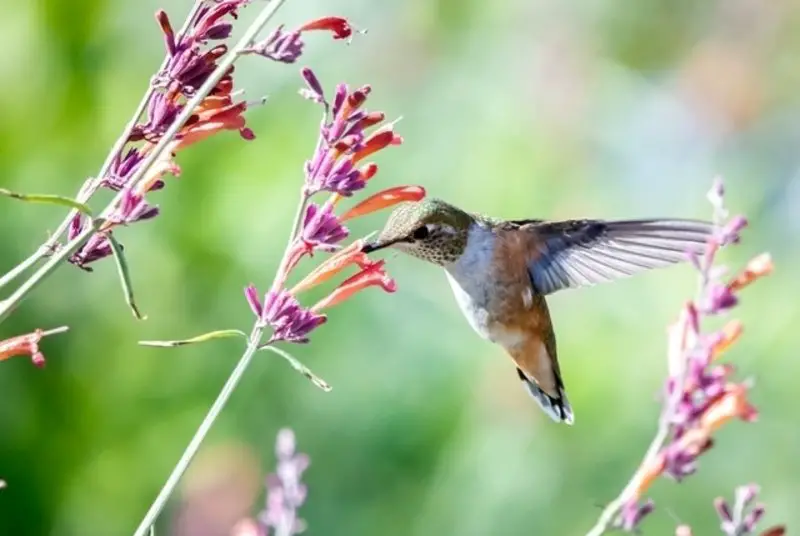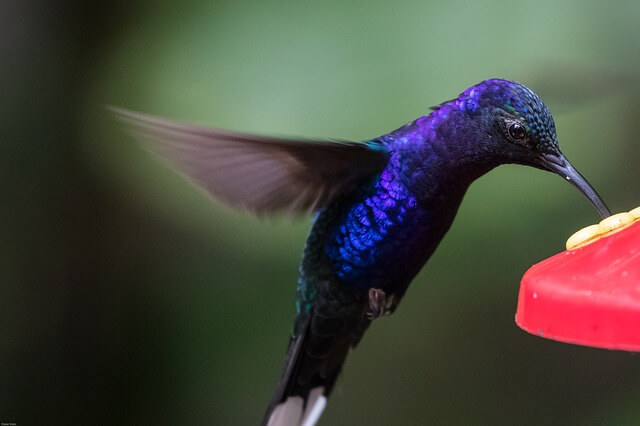Where do Hummingbirds go in the Winter? Hummingbirds are a common sight in many places throughout North America, especially during the summer months. However, there is often confusion as to what they do when it starts getting cold outside.
The truth is that not all hummingbirds migrate south for the winter, and some stay here year-round. In this article, we will be discussing what hummingbirds do during their migration and how they survive through these colder months.
Table of Contents
- 1 Key Takeaways:
- 2 Where do hummingbirds go in the winter?
- 3 What time of year do hummingbirds migrate?
- 4 How do hummingbirds survive in the winter?
- 5 How can I attract more hummingbirds?
- 6 What is the lowest temperature a hummingbird can survive?
- 7 Should you leave hummingbird feeders out in winter?
- 8 Do hummingbirds come back to the same place every year?
- 9 What month do I take down my hummingbird feeder?
- 10 Where do hummingbirds go at night?
- 11 What is the lifespan of a hummingbird?
- 12 How can you tell a male from a female hummingbird?
- 13 Where is the best place to hang a hummingbird feeder?
- 14 What is a hummingbird’s favorite flower?
- 15 What time of day do hummingbirds feed the most?
- 16 How many types of hummingbird species are there?
- 17 What is the most common type of hummingbird?
- 18 What country has the most hummingbirds?
- 19 Do hummingbirds sing?
- 20 Do hummingbirds eat birdseed?
- 21 When to stop feeding hummingbirds?
- 22 How much do hummingbirds weigh?
- 23 How many hummingbird species are there?
- 24 Can hummingbirds fly backwards?
- 25 Author
Key Takeaways:
- Migration: Most hummingbirds migrate to warmer climates in winter to avoid harsh conditions.
- Tropical Destinations: Hummingbirds often travel to Central America or Mexico during the colder months.
- Energy Conservation: Migration helps hummingbirds conserve energy by finding better food sources and warmer temperatures.
- Torpor State: Some hummingbirds enter a state of torpor during chilly nights, lowering their metabolic rate to survive.
- Feeder Maintenance: If you have hummingbird feeders, it’s crucial to keep them clean and filled during winter for any non-migratory or early-returning species.
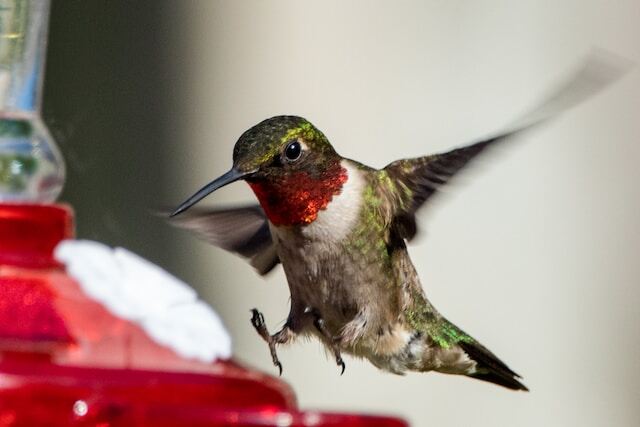
Where do hummingbirds go in the winter?
Hummingbirds migrate in order to find food and avoid the cold. When winter arrives, hummingbirds go south of the border to Mexico, the Caribbean, and Central America are some of their favorite places to migrate. These regions are much warmer, and have a greater variety of plant life than what is available in the United States, making them more likely to find food and survive.
What time of year do hummingbirds migrate?
Migration season typically begins in August or September, and they will start returning to their breeding places in the (Western and the Southern US states) in February, and will travel further northward to Canada as the weather warms up a bit more, typically in May.
How do hummingbirds survive in the winter?
Most people don’t know, but hummingbirds survive the winter by migrating south to Mexico or Central America for the winter months. The ones that stay go into a state of torpor during the winter. Torpor is an animal’s hibernation-like state that they enter to conserve energy when food is scarce or environmental conditions are too cold.
The body temperature and heart rate slow down, and the bird may sleep for up to 12 hours per day. During this time, hummingbirds consume less than half as much food as they would normally need to survive on a daily basis.
A hummingbird is a warm-blooded animal because it produces heat internally through its metabolic activity, and regulates its body temperature via physiological mechanisms like shivering or piloerection. This enables them to live in cold climates that would otherwise be too low for other animals of similar size.
How can I attract more hummingbirds?
There are many ways to attract hummingbirds to your garden. Here are some of the best methods for attracting these beautiful birds. The following recommended products below are direct linked to Amazon.
- Include a large variety of plants with nectar-producing flowers and feeders in the mix. A good idea is to mix up a few different kinds of flowers in your garden. Here is a list of plants that Hummingbirds love: Roses, fuchsias, petunias, lantanas, phloxes.
- Provide water for drinking, bathing, and preening by placing birdbaths near bushes or trees with foliage that is attractive to hummingbirds such as red berries, dogwood blossoms, crab apple blossoms, etc., or hang a container filled with a shallow layer of water near the flowers or berries.
- Hummingbirds love sugar water, and their wings can’t beat very fast, so a shallow layer of water near the flowers or berries is what they want to keep coming back for more!
- They are looking for food and will be drawn to your feeder if you put it in a flowery garden with plants that bloom all year long such as Butterfly Bushes or Salvia.
- You can attract them with hummingbird feeders by mixing water & sugar. All you need to do is mix 1 part table sugar with 4 parts boiling water and stir until the sugar dissolves. Then let it cool down for about 30 minutes before filling up your feeders or pouring into a glass jar with holes poked in the lid for easy access.
- Place the feeder close to where they can easily find it.
- A bird feeder should be hung about 10 feet away from a window, so that sunlight will not be blocked when they fly to it. Place the feeder in an area where there is plenty of sunlight, and cover it with netting if necessary.
What is the lowest temperature a hummingbird can survive?
As tiny creatures, hummingbirds can survive in temperatures as cold as 32° F (0 °C). In these temperatures, hummingbirds go into a state called torpor. This is a kind of hibernation where the birds slow their metabolism down to conserve energy. Hummingbirds can survive in this state for 5 to 10 hours without food or water.
Should you leave hummingbird feeders out in winter?
Normally, hummingbirds will stop feeding around the end of November or early December, but they may stay active until late January if feeders are left out. If you remove a hummingbird feeder too soon, the birds may become inactive and not return until spring.
Do hummingbirds come back to the same place every year?
Hummingbirds have an amazing ability to remember specific places where they have fed in the past. This is likely because their brains are specially adapted for long-term memory storage. Studies have found that most hummingbirds return to the same feeders every year, despite the fact that these feeders may be placed in different locations.
This phenomenon is one of the many fascinating characteristics of these birds. Hummingbirds rely on their memories to find food and shelter, so it is no wonder that they are so successful in their natural habitats.
What month do I take down my hummingbird feeder?
If you live in the northern US states, like I do, remove your hummingbird feeder during the month of October. This is when most of the hummingbirds have migrated south for the winter. If you live in the southern US states, like many people do, leave your feeder up until Thanksgiving. If you live in a warm climate, you can leave your feeder up all winter.
Where do hummingbirds go at night?
During the night, hummingbirds will often find sheltered spots in trees where they can sleep on tree branches in upside down positions. This is a way of protecting themselves from predators, and it gives them a chance to conserve energy.
What is the lifespan of a hummingbird?
In North America, the life expectancy of a wild hummingbird is about 3-5 years. The lifespan varies depending on how many predators they have and where they live.
Hummingbirds usually die from natural causes like starvation or dehydration, old age, predation by other animals, or injury from accidents in nature. In captivity, however, they can live up to 12 years.
How can you tell a male from a female hummingbird?
Male hummingbirds have a patch of bright-colored feathers on their throats called a gorget. Female hummingbirds don’t have this feature, so it’s easy to tell them apart. Additionally, female hummingbirds have a longer bill than male counterparts.
Also, the colors of their plumage also play an important role in identifying them as male or female. The males have a flamboyant colored feathers, which they show prominently during mating displays when trying to attract potential mates and during social interactions.
Where is the best place to hang a hummingbird feeder?
Where to hang a Hummingbird Feeder is a question every backyard gardener asks. These small birds visit feeders all year round, from spring till fall. Here are some suggestions on where to hang your hummingbird feeders.
- The best place to hang a hummingbird feeder is outside on the east side of your house. The reason for this is that hummingbirds prefer sunlight and an east-facing window provides direct sunlight in the morning. It also helps if you put it in front of flowers, plants or bushes that attract other birds as well.
- Place it close enough that you can enjoy watching them fly in and out. Use a tree or post at least 12 feet high. -Do not hang your feeder within 10 feet of anything taller than it is (including other trees). If possible, avoid hanging the feeder under eaves or roof overhangs.
- Make sure that your bird feeder has an adequate distance from any house or window, as this can frighten the birds and cause them to fly away. It’s also good to make sure that you keep it out in the open instead of behind bushes or trees
What is a hummingbird’s favorite flower?
The most common flowers for hummingbirds are red tubular flowers such as bee balm, cardinal climber, honeysuckle, trumpet vine and fuchsia.
Other flowers that they enjoy are morning glorys, columbine, erythroniums, Indian paintbrushs, lupines, jasmine, marigold, and tulips.
What time of day do hummingbirds feed the most?
It turns out that it depends on the species. Ruby-throated hummingbirds feed most often at dawn and dusk. Anna’s hummingbirds can be seen all day long, though they tend to eat more around noon. Black chinned hummingbirds may seem to only show up at night, but they also like to feed early in the morning or late in the evening.
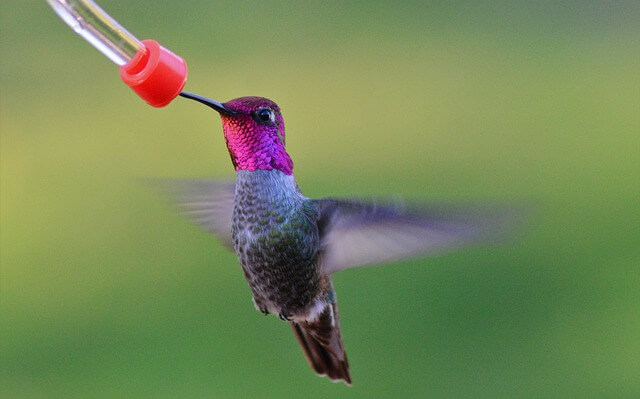
How many types of hummingbird species are there?
Hummingbirds are perhaps the most well-known bird species in the world. There are over 330 species of hummingbirds in the world, with 160 species occurring in North America and 200-250 species occurring in South America. These tiny birds can be found all over the world, from temperate zones to tropical rainforests.
What is the most common type of hummingbird?
The Ruby-throated hummingbird and the Anna’s hummingbird are the most common types of hummingbirds in North America. These two birds can be found in nearly every state in the United States, as well as portions of Canada and Mexico. Other slightly less common types of hummingbirds include the Black-chinned hummingbird, Costa’s Hummingbird, and the Broad-tailed Hummingbird.
What country has the most hummingbirds?
The country with the most hummingbirds is Ecuador. This may come as a surprise to many people, because they are more likely to think of Costa Rica or other Central American countries when it comes to wildlife.
However, Ecuador has almost three times as many hummingbirds than any other country in the world! The country of Ecuador is home to over 160 species of hummingbirds.
Do hummingbirds sing?
Hummingbirds are known to produce a wide variety of notes, some of which have never been heard before. These tiny birds have an elaborate syrinx (voice box) that enables them to produce all sorts of sounds.
These include squeals, chirps and trills as well as complex songs which some experts believe may be used in mating rituals. They start by making a high-pitched noise and then lowering the pitch until it becomes a humming sound.
Hummingbirds can also change the pitch and volume of their songs depending on what they are trying to communicate. For example, when they are trying to attract a mate, their songs will be higher pitched and softer. When they are defending themselves or their territory, their songs will be lower pitched and louder.
If you’re wondering which species has the best song, the title would go to the male, Anna’s hummingbird. This bird is considered the best singing hummingbird in North America. He can produce a wide variety of notes, and his singing is often used to attract mates.
Do hummingbirds eat birdseed?
Hummingbirds are not known for their voracious appetites, but many people believe that they consume birdseed as a part of their diet. In reality, they do not eat seed-based foods. Hummingbirds cannot open or digest seeds, which is why they rely so heavily on nectar, and insects.
Hummingbirds have a long tongue and skilled beak that enable them to extract the nectar from flowers with great efficiency. Hummingbirds are very picky creatures when it comes to what they eat, so if you want to attract them, offer up some sweet nectar instead!
When to stop feeding hummingbirds?
The best time to stop feeding hummingbirds is when the flowers in your garden start blooming. Hummingbirds will fly from flower to flower, gathering nectar for their diet. It’s only a matter of time before they find food elsewhere and leave your feeder alone.
Here are some guidelines on when it’s time to stop feeding hummingbirds.
In the summer months, one can expect hummers around from about March until October in many areas of North America. They’ll typically visit flowers early in the morning and then again in late afternoon or early evening.
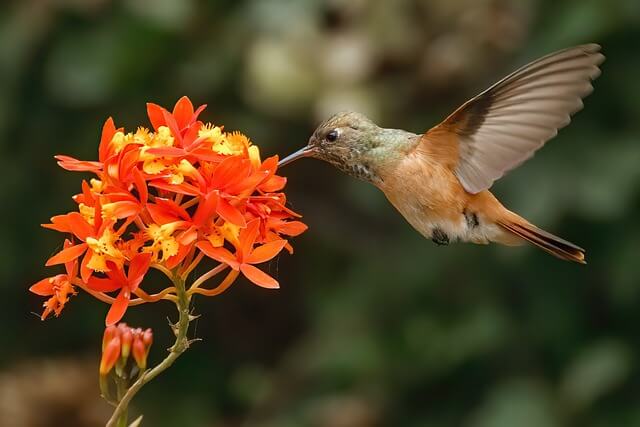
How much do hummingbirds weigh?
The smallest species of hummingbird is the Bee Hummingbird that weighs only 1.5 grams while the largest species, the Giant Hummingbird is native to Costa Rica, and weighs around 20 grams in weight.
How many hummingbird species are there?
Hummingbirds are one of the most popular bird species in the world. There are over 330 hummingbird species and 115 genera worldwide, and they can be found all over the planet. These birds are known for their amazing flight abilities, their brightly colored plumage, and their sweet song.
Can hummingbirds fly backwards?
Hummingbirds are amazing creatures. They have the ability to fly forwards, backwards, and even upside down! How do they do it? Let’s find out. First, when a hummingbird flies up in the air, its wings have an up-and-down motion called “vertical undulation.”
When a hummingbird is on the ground or hovering near the ground like a helicopter does to stay in one place, its wings move from side to side (called “horizontal hovering”).
Their wings also have an asymmetrical shape which allows them to spin in any direction while hovering, enabling them to reverse their course quickly if needed. They also have a unique tail feather arrangement that helps steer themselves in the air when flying forwards or backwards.

